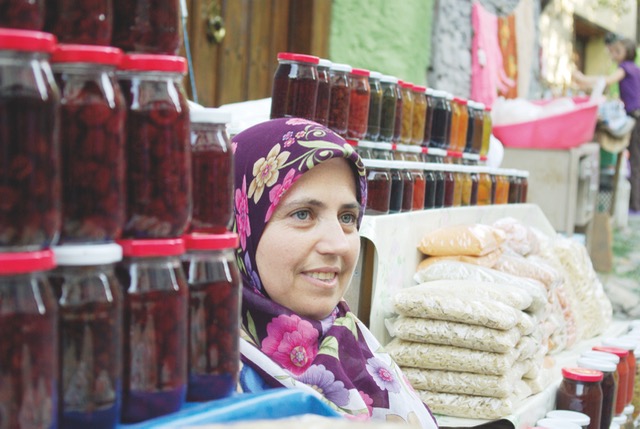When the community is part of the heritage

Cumalıkızık is the best preserved of one of seven historic ‘Kızık’ villages, of which five are still extant, situated in the northern foothills of Uludağ to the east of Bursa and about 10km from the city centre. A Waqf village established by Orhan Gazi with its origins in the 14th century C.E., Cumalıkızık serves as an historic example of the model of rural-urban integration under the Ottomans which underpinned the development of Bursa and, subsequently, the Ottoman Empire. The 700 year old village is regarded as one of the best preserved examples of rural architecture from the Ottoman Empire, with traditional houses that have retained their original plans and construction materials and techniques, and, with its water courses and steeply cobbled streets, which give access to wide areas of village garden cultivation, the whole village creates the ‘feel’ of the Early Ottoman Period. A number of successful films and TV series made in the village from the 1970s onward have capitalised on and popularised the historical ambience and authenticity of the village, and contributed to its growing popularity with visitors over the past 15 years, primarily as a day-trip destination for domestic Turkish tourists, and, increasingly, for international visitors from Europe and the Gulf States.
Cumalıkızık’s reputation and attraction as an ‘open air museum’ is based not only on the tangible texture of its buildings, cobbled streets and narrow alleyways, but on the intangible values of its social and cultural fabric. Continuous habitation by five or six extended families has resulted in a dense web of kinship relations and property ownership within the village. Houses and property in the village have been kept in village hands, and, although the area of village land under cultivation has declined over recent years, the villagers’ innate conservatism and continued commitment to maintaining the traditions of forestry and horticultural cultivation and production, on which the village was founded, are credited with having created and sustained a unique balance between urban and rural systems of production and consumption. Cumalıkızık’s significance was acknowledged in 2014 with the UNESCO World Heritage Site designation of Bursa and Cumalıkızık – The Birth of the Ottoman Empire.
In 2015 the village was selected as one of the pilot destinations for implementing the model of sustainable community based tourism (SCBT) being developed as part of the project Touch TD is working on with UNDP Turkey and the Turkish Ministry of Culture and Tourism. Tourism is becoming an increasingly dominant activity in the life of the village, and is drawing back villagers who left years ago for work and education in nearby Bursa or in Istanbul. The tourists are providing an important market for the village’s agricultural products, with market stalls selling the home made jams, linden tea, chestnut honey, fruit and dried goods produced from the village gardens and the surrounding forest. But at the same time, tourism is now starting to compete with the village horticulture for scarce resources, including space. Tractors are unable to get out into their gardens because of the crowds of tourists in the streets, and there are complaints of damage and theft of crops. Some of these losses are blamed on the encroaching urban settlement from Bursa, whose expanding industries have been a magnet for rural migrants from all over Turkey, as well as the growing refugee population from Syria. Residents of the nearby settlement, which has grown up on former village land, also look to the tourists visiting the World Heritage Site as a potential income stream, although, so far, they have been unable to capture any of the benefits. Visiting the site, we were confronted with a number of questions: how can Cumalıkızık sustain the values of place and identity, for which it has been listed, in times of such dramatic change? How inclusive is the notion of ‘World Heritage’ – does it extend to the new settlers across the fields? Where does ‘the community’ start and end? And how does it work?
Having at one time apparently been all for the idea of bounded communities and holistic community-based studies, anthropologists now tend to be very cagey about the notion, and quite forensic in deconstructing the basis for claims of ‘community’. On the one hand, it has an atavistic appeal, in the case of Cumalıkızık harking back to the centuries of continuous settlement and the sense of place that has emerged from that. On the other hand, it represents a localised form of informal, grassroots governance, sitting somewhat uneasily with more formal governance structures. In the case of SCBT models, it can easily be confused with a kind of niche tourism product, based on selling a nostalgic idea of the community to outsiders. Finally, policy makers, consultants, and other outside agencies, may be operating with a model of ‘community’ entirely different from the social maps according to which local people live their lives and set their priorities. In connection with tourism, which frequently gives rise to conflicts of interest and resources, the terminology of ‘community’ and ‘cooperation’ may conceal individualised competition and social rifts, and sometimes surprising alliances and convergences of interest across ‘community’ boundaries; whilst the association of ‘community’ with settled places underplays the extent to which large groups of people are increasingly on the move, as evidenced by Europe’s current preoccupation with its ‘refugee crisis’.
Whilst its UNESCO listing references a particular moment in Ottoman civilisation, the tensions in the relationship between urban and rural, mobility and stability, which Cumalıkızık continues to embody, have entirely global and contemporary relevance, at a point in human history where the balance between the urban and the rural has tipped inexorably towards the urban. The idea of ‘community’ continues to exert a fascinating hold, but the pressures of bridging the gap between adaptation to the modern world, and sustaining the heritage values of the past, stretch even this elastic concept close to breaking point.
